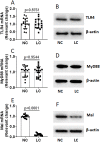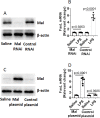Restoration of Mal overcomes the defects of apoptosis in lung cancer cells
- PMID: 31978067
- PMCID: PMC6980397
- DOI: 10.1371/journal.pone.0227634
Restoration of Mal overcomes the defects of apoptosis in lung cancer cells
Retraction in
-
Retraction: Restoration of Mal overcomes the defects of apoptosis in lung cancer cells.PLoS One. 2023 Dec 28;18(12):e0296552. doi: 10.1371/journal.pone.0296552. eCollection 2023. PLoS One. 2023. PMID: 38153921 Free PMC article. No abstract available.
Abstract
Background and aims: Cancer is one of the life-threatening diseases of human beings; the pathogenesis of cancer remains to be further investigated. Toll like receptor (TLR) activities are involved in the apoptosis regulation. This study aims to elucidate the role of Mal (MyD88-adapter-like) molecule in the apoptosis regulation of lung cancer (LC) cells.
Methods: The LC tissues were collected from LC patients. LC cells and normal control (NC) cells were isolated from the tissues and analyzed by pertinent biochemical and immunological approaches.
Results: We found that fewer apoptotic LC cells were induced by cisplatin in the culture as compared to NC cells. The expression of Fas ligand (FasL) was lower in LC cells than that in NC cells. FasL mRNA levels declined spontaneously in LC cells. A complex of FasL/TDP-43 was detected in LC cells. LC cells expressed less Mal than NC cells. Activation of Mal by lipopolysaccharide (LPS) increased TDP-43 expression in LC cells. TDP-43 formed a complex with FasL mRNA to prevent FasL mRNA from decay. Reconstitution of Mal or TDP-43 restored the sensitiveness of LC cells to apoptotic inducers.
Conclusions: LC cells express low Mal levels that contributes to FasL mRNA decay through impairing TDP-43 expression. Reconstitution of Mal restores sensitiveness of LC cells to apoptosis inducers that may be a novel therapeutic approach for LC treatment.
Conflict of interest statement
The authors have declared that no competing interests exist.
Figures






References
Publication types
MeSH terms
Substances
LinkOut - more resources
Full Text Sources
Medical
Research Materials
Miscellaneous

